
A spring-loaded camming device is a piece of rock climbing or mountaineering protection equipment. It consists of two, three, or four cams mounted on a common axle or two adjacent axles, so that pulling on the axle forces the cams to spread farther apart. This is then attached to a sling and carabiner at the end of the stem. The SLCD is used by pulling on the "trigger" so the cams retract together, then inserting it into a crack or pocket in the rock and releasing the trigger to allow the cams to expand. A pull on the rope, such as that generated by a climber falling, will cause a properly placed SLCD to convert the pulling force along the stem of the unit into outwards pressure on the rock, generating massive amounts of friction and preventing the removal of the unit from the rock. Because of the large forces which are exerted on the rock when an SLCD is fallen on, it is very important that SLCDs are only placed in solid, strong rock.
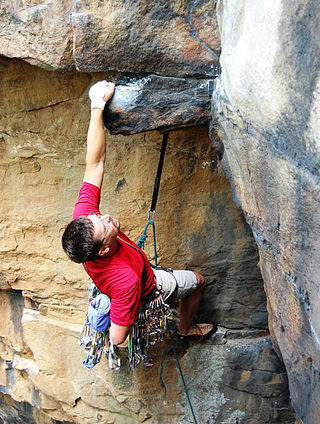
Traditional climbing is a type of free climbing in rock climbing where the lead climber places the protection equipment while ascending the route; when the lead climber has completed the route, the second climber then removes the protection equipment as they climb the route. Traditional climbing differs from sport climbing where the protection equipment is pre-drilled into the rock in the form of bolts.

Glossary of climbing terms relates to rock climbing, mountaineering, and to ice climbing.

Rock-climbing equipment varies with the type of climbing undertaken. Bouldering needs the least equipment outside of shoes and chalk and optional crash pads. Sport climbing adds ropes, harnesses, belay devices, and quickdraws to clip into pre-drilled bolts. Traditional climbing adds the need for carrying a "rack" of temporary passive and active protection devices. Multi-pitch climbing adds devices to assist in ascending and descending fixed ropes. And finally aid climbing uses unique equipment.

A bouldering mat or crashpad is a nylon-enclosed multi-layer foam pad used for protection when bouldering. Bouldering mats help prevent climbers from injuring themselves from the continuous and repeated falls onto hard or uneven surfaces that are associated with projecting a bouldering problem.

Black Diamond Equipment is a manufacturer of equipment for climbing, skiing, and mountain sports, based in Utah, United States. The company also has a global office in Innsbruck, Austria. The company is owned by Clarus Corporation, which also owns Pieps, ClimbOn! Skincare, and Sierra Bullets.
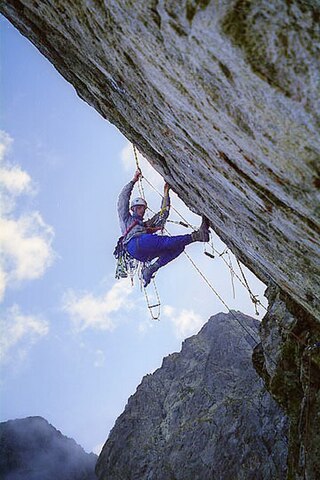
Aid climbing is a form of rock climbing that uses mechanical devices and equipment, such as aiders, for upward momentum. Aid climbing is different than free climbing, which only uses mechanical equipment for protection, but not to assist in upward momentum. Aid climbing sometimes involves hammering in permanent pitons and bolts, into which the aiders are clipped, but there is also 'clean aid climbing' which avoids any hammering, and only uses removable placements.
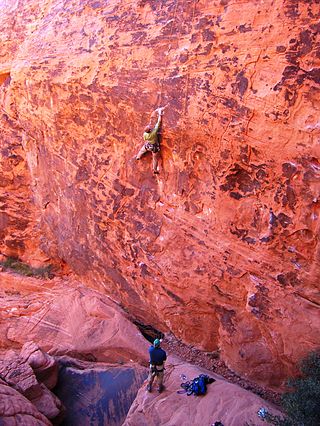
Top rope climbing is a form of rock climbing where the climber is securely attached to a climbing rope that runs through a fixed anchor at the top of the climbing route, and back down to the belayer at the base of the climb. A climber who falls will just hang from the rope at the point of the fall, and can then either resume their climb or have the belayer lower them down in a controlled manner to the base of the climb. Climbers on indoor climbing walls can use mechanical auto belay devices to top rope alone.
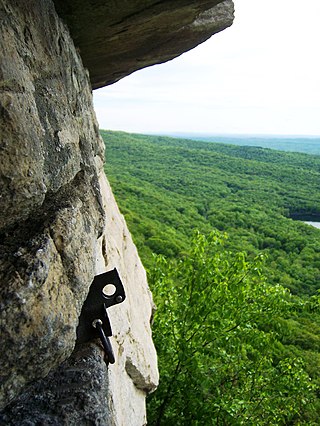
Clean climbing is rock climbing techniques and equipment which climbers use in order to avoid damage to the rock. These techniques date at least in part from the 1920s and earlier in England, but the term itself may have emerged in about 1970 during the widespread and rapid adoption in the United States and Canada of nuts, and the very similar but often larger hexes, in preference to pitons, which damage rock and are more difficult and time-consuming to install. Pitons were thus eliminated in North America as a primary means of climbing protection in a period of less than three years.
Ben Moon is a rock climber from England. During the late 1980s and early 1990s, Moon, along with climbing partner Jerry Moffatt, were the two strongest British rock climbers and were key pioneers in the development of standards in international sport climbing. In 1991, Moon made the first-ever redpoint in history of a consensus grade 8c+ (5.14c) climbing route with his ascent of Hubble.
Ray Jardine is an American rock climber and rock-climbing equipment innovator, who specialized in traditional climbing and big wall climbing. In 1997, Jardine made the first free ascent of The Phoenix, which was the first-ever consensus route at the grade of 5.13a (7c+) in climbing history. In 1979, with Bill Price, he became the first to free climb the West Face of El Capitan in Yosemite Valley.

Rock climbing is a sport in which participants climb up, across, or down natural rock formations or indoor climbing walls. The goal is to reach the summit of a formation or the endpoint of a usually pre-defined route without falling. Rock climbing is a physically and mentally demanding sport, one that often tests a climber's strength, endurance, agility and balance along with mental control. Knowledge of proper climbing techniques and the use of specialized climbing equipment is crucial for the safe completion of routes.
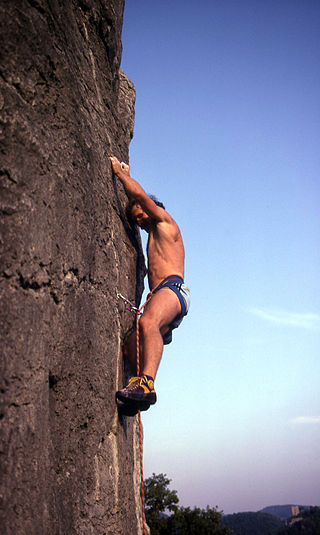
In rock climbing, redpointing means to free-climb a climbing route from the ground to the top while lead climbing, after having practiced the route or after having failed first attempt. Climbers will try to redpoint a route after having failed to onsight it, or flash it. The first successful redpoint of a route, in the absence of any prior onsight or flash, is recorded as the first free ascent (FFA) of that route.

Ailladie, is an 800-metre-long (2,600 ft) west-facing limestone sea cliff, that varies in height from 8 metres (26 ft) to 35 metres (115 ft), situated on the coast of The Burren in County Clare, Ireland. Ailladie is one of Ireland's most highly regarded rock-climbing locations, particularly for high technical grade single pitch traditional climbing routes and deep-water soloing routes. It is also a location for shore-angling competitions, and, with its cliffs and view of the Aran Islands, is a popular photography stop for tourists.

A belay device is a mechanical piece of climbing equipment used to control a rope during belaying. It is designed to improve belay safety for the climber by allowing the belayer to manage their duties with minimal physical effort. With the right belay device, a small, weak climber can easily arrest the fall of a much heavier partner. Belay devices act as a friction brake, so that when a climber falls with any slack in the rope, the fall is brought to a stop.
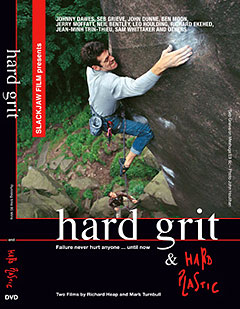
Hard Grit is a 1998 British rock climbing film directed by Richard Heap and produced by Slackjaw Film, featuring traditional climbing, free soloing, and bouldering on gritstone routes in the Peak District in Northern England. It is considered an important film in the genre and regarded as a historic and iconic film. The film starts with a dramatic fall by French climber Jean–Minh Trinh-Thieu on Gaia at Black Rocks. Hard Grit won ten international film festival awards.
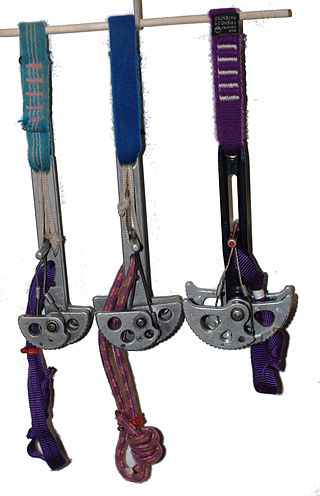
Wild Country is a major manufacturer of rock-climbing equipment, and is most noted for introducing the Friend, a spring-loaded camming device. The company is based in Tideswell in the English Peak District, close to some of the UK's most popular climbing areas.
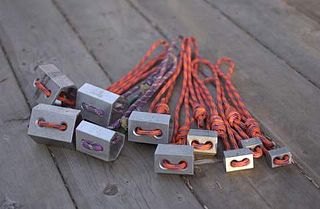
A hex is an item of rock-climbing equipment used to protect climbers from falls. They are intended to be wedged into a crack or other opening in the rock, and do not require a hammer to place. They were developed as an alternative to pitons, which are hammered into cracks, damaging the rock. Most commonly, a carabiner will be used to join the hex to the climbing rope by means of a loop of webbing, cord or a cable which is part of the hex.
Malcolm Smith is a Scottish rock climber and competition climber who won the bouldering IFSC Climbing World Cup in 2002.

Mark Vallance was a British rock climber, mountaineer and founder of Wild Country, a climbing equipment company.























